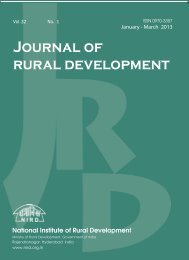Manual for Integrated District Planning - National Institute of Rural ...
Manual for Integrated District Planning - National Institute of Rural ...
Manual for Integrated District Planning - National Institute of Rural ...
You also want an ePaper? Increase the reach of your titles
YUMPU automatically turns print PDFs into web optimized ePapers that Google loves.
<strong>Manual</strong> <strong>for</strong> <strong>Integrated</strong> <strong>District</strong> <strong>Planning</strong><br />
Spatial planning has to be part <strong>of</strong> the district planning process at all levels. However,<br />
if technology, capacity and the lack <strong>of</strong> guidelines are limiting factors, they must at<br />
least permeate to the level <strong>of</strong> the municipality plan, if not at the ward-level plans<br />
to begin with. This will give an idea to all the local representatives <strong>of</strong> the spatial<br />
element <strong>of</strong> each level’s plan. Examples <strong>of</strong> spatial planning undertaken in India are<br />
described in Boxes 62 and 63.<br />
Box 62: Spatial planning in Kollam district, Kerala<br />
Kollam district in Kerala has wide ecological diversity ranging from the Western Ghats<br />
to the Arabian sea coast. In 2003, the Kollam <strong>District</strong> <strong>Planning</strong> Committee initiated<br />
the preparation <strong>of</strong> an integrated district development plan and local development<br />
plan with special emphasis on the spatial aspect, under a project <strong>of</strong> the State <strong>Planning</strong><br />
Board, Kerala. The project aimed at further improving the well-established process<br />
<strong>for</strong> preparation <strong>of</strong> development plans from the Panchayats and municipalities, by<br />
introducing the spatial element into the decentralised planning process. The spatial<br />
aspect was to be incorporated into every aspect <strong>of</strong> planning, such as data collection<br />
as part <strong>of</strong> the stock-taking and envisioning exercise, presentation <strong>of</strong> data to decision<br />
makers in the <strong>District</strong> <strong>Planning</strong> Committee and Panchayats, and finally to help in<br />
visualising and depicting the plan. Because in<strong>for</strong>mation was being collected and<br />
presented location wise, the exercise hoped to prompt and encourage thinking in<br />
the direction <strong>of</strong> proper land use planning. The project used geographic in<strong>for</strong>mation<br />
system (GIS) technology, which converged satellite images, cadastral data and socioeconomic<br />
survey data in tabular <strong>for</strong>m and integrated it into spatial presentations.<br />
Sectoral analysis was done <strong>for</strong> 18 development sectors ranging from the primary<br />
sector, to basic services in health education, provision <strong>of</strong> water, poverty alleviation<br />
and rural development, infrastructure (roads, bridges, housing), <strong>for</strong>ests, environment,<br />
mining and geology, social welfare, women and child development, power and<br />
telecommunication, tourism, culture, sports and youth affairs. In each <strong>of</strong> these<br />
sectors both problems and initiatives were identified with location specific details.<br />
Similarly, an analysis <strong>of</strong> the completed projects/programmes was done with locationspecific<br />
analysis and suggestions. The exercise also incorporated human resource<br />
development and availability <strong>of</strong> finances and presented these aspects spatially. Thus,<br />
at every stage <strong>of</strong> the decentralised planning process and participative planning,<br />
stakeholders were not only prompted to give suggestions on overall development<br />
but also to take decisions as to the appropriate locations. There<strong>for</strong>e, spatial decisions<br />
also got captured into the participative process with prompting <strong>of</strong> suggestions and<br />
solutions by the <strong>District</strong> <strong>Planning</strong> Committee.<br />
Consequently, the integrated development plan <strong>of</strong> Kollam now contains a perspective<br />
plan <strong>of</strong> 15-20 years dealing with long term issues such as settlement patterns, district<br />
level policies <strong>for</strong> integrated development cutting across urban and rural areas, the<br />
best spatial strategy that might be adopted <strong>for</strong> optimum utilisation <strong>of</strong> resources and<br />
the long term perspective <strong>for</strong> regional infrastructure which covers water management,<br />
energy, transport network and tourism. An execution plan has been drawn out from<br />
this perspective plan and is implemented and monitored.<br />
The project has given decision makers in local governments, the <strong>District</strong> <strong>Planning</strong><br />
Committee and other stakeholders the opportunity to consider and take decisions<br />
in the emerging area <strong>of</strong> spatial planning. The Kollam experience, particularly the<br />
methodologies developed by it can be easily upscaled to other districts too.<br />
111

















